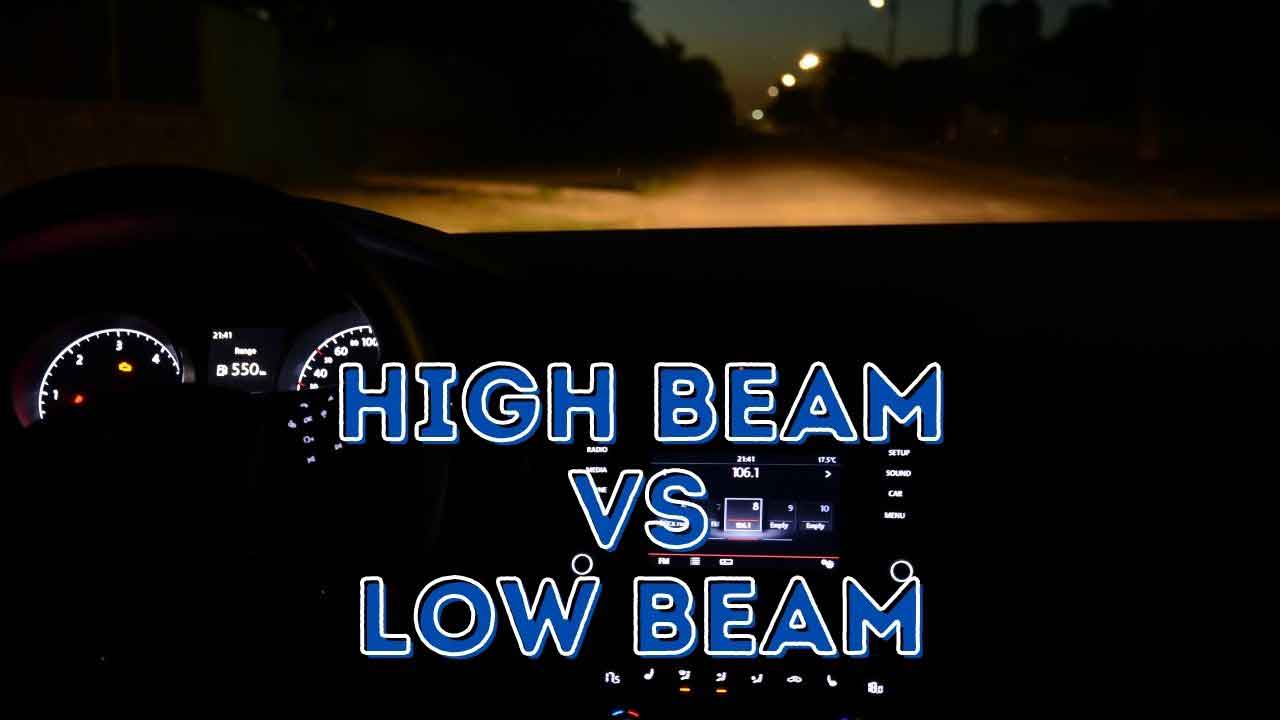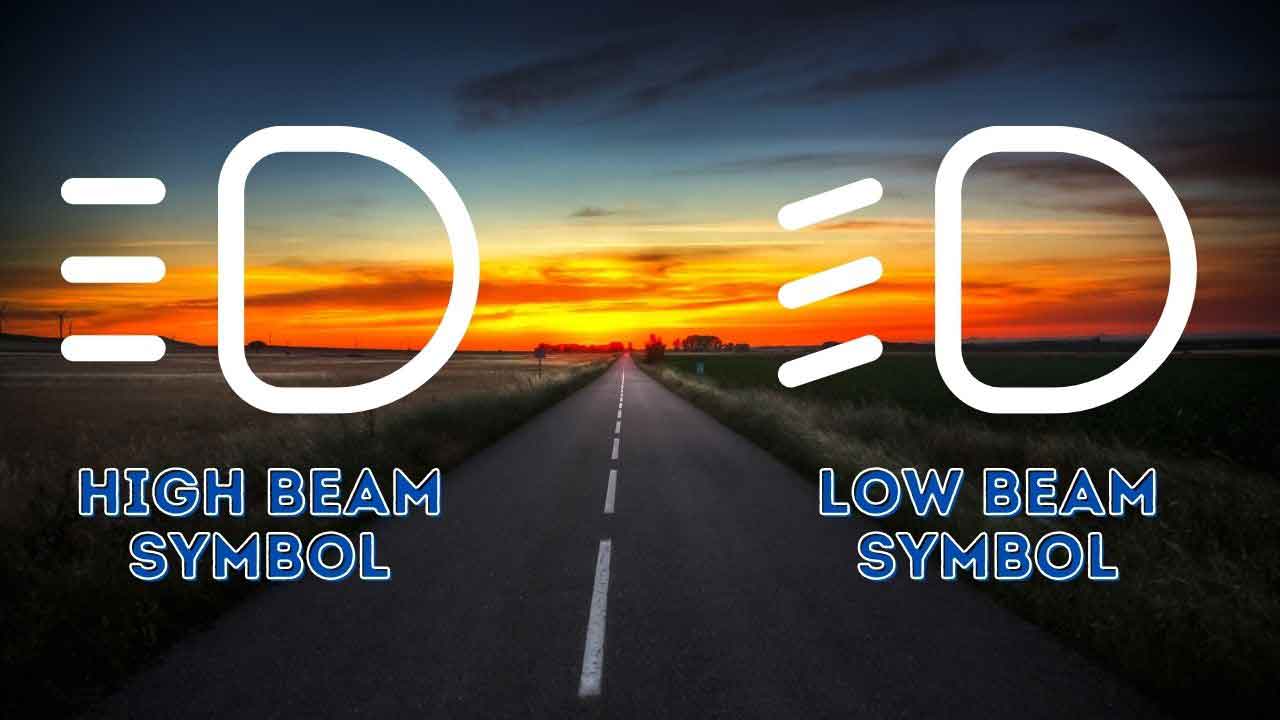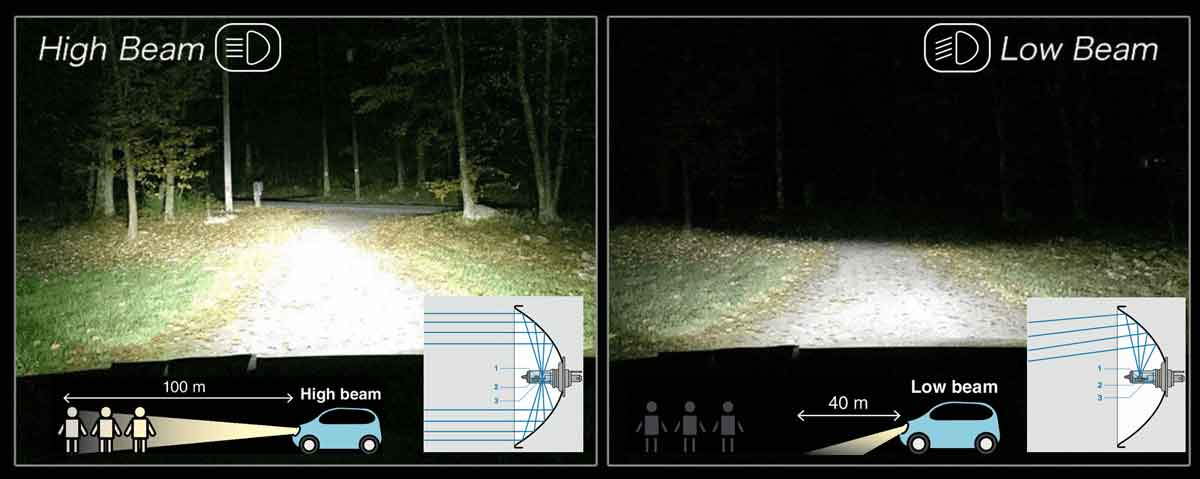Headlights are an integral part of your vehicle. While we can differentiate types of headlights on many criteria, this article is all about high beams and low beams with their differences.

As everyone needs to use both high and low beams when driving, it is a must to know when to use them to avoid expensive traffic tickets.
In this article, we have defined the high and low beams, differences between them with answers to some relevant questions like when and when not to use high and low beams along with some other relevant information. Keep reading!
What is Low Beam?
Low beam, alternatively known as dipped beam headlights are the pair you use generally in night driving. Low beam refers to the headlight that is aimed downward to prevent blinding out the oncoming drivers while illuminating the road sufficiently.
To prevent excessive glare and dazzling other drivers on the road, low beams are comparatively less bright than high beams. It is made to produce light just sufficiently so that you get optimal illumination to drive safely without impairing other drivers’ visibility.
Because of its beam aiming down to the road, these headlights are called low beam headlights.
The general rule for the low beams is the light should have a cut off at exactly on the window line of the vehicle at a distance of 25 feet. That means the light should not get into the other road users’ eyes when he is at a distance of around 9 meters from you.
The overall distance low beam lights cover is around 100 to 150 feet depending on the quality and type of your headlight. Halogen headlights are lower in the range while laser headlights are on the longer side.
What is High Beam?
High beam or full beam headlights are the opposite of what we have described under the low beam. That is- High beams are very bright that let you see far from the vehicle with more centralized light distribution.
The light is aimed straight towards the front of the vehicle, or sometimes slightly upwards to allow the driver to see everything on the road. In general, the high beam headlights will illuminate at least 300 feet in front of the vehicle.
While the low beam is for driving on the busy traffic road, high beams are for getting better visibility in low light conditions, especially in rural and very dark country roads.
When to Use Low Beam Headlights?
You will use the low beam almost always while driving on the city streets. That’s because city roads are illuminated by lamp posts, household lights, and the other vehicles that are on the road.
To get an idea about the high beam usage, We have asked 237 people who are driving vehicles for more than a decade – “how many times you use high beam compared to the low beam headlights?”
84% of them said (199 out of 237) – They have not used the high beam in the last week. And only 38 of them have used their high beam lights in the previous week once or more.
So, you can clearly see the low beam is the go-to headlight when you are driving and the high beam is for occasional use.
Are High Beam Headlights Legal?
Yes, high beam headlamps are legal and you should use them when necessary.
In instances like driving in a rural area, in blackout situations, and when off-roading, it is mandatory to use high beam lights for road safety.
When to Use High Beam Headlights?
High beams are for the 100% or near 100% dark situations when you can’t see anything out of the range of your low beam headlamps. So, urban areas don’t fall in this criteria as there are many lamp posts on the road, and other light sources are also present as well. So, you can see what is next without switching to the high beam mode.
But on rural roads, when you are off-roading at night, there is nothing to light up the dark road except your headlights. While the low beam can give you some idea of what is next, it is not a good fit for such roads as you won’t be able to speed up.
So, high beam headlights come into play to give you more freedom in terms of speed. Plus, it makes your ride safe and comfortable too.
Apart from these, open highways or interstate highways may require high beams if they are not well lit.
When not to Use High Beams?
As we have described the conditions when you need to light up the high beam, it is our duty to keep you updated about the restrictions as well. Here are some of the most common situations when you should not use high beams-
1. Vehicles Are in Close Distance
When vehicles are in close distance of your car, you must not use high beams to be safe and keep the other drivers harmless.
There are different laws on this. Generally, you can’t use high beams when there is an oncoming vehicle within 500 feet of distance from your vehicle. If your high beam is lit and you see a vehicle approaching from the opposite, you must dim the high beam and light up the low beam for a safe crossing.
That’s not all. When you are following a vehicle on the road at a distance, not more than 200 feet, you must turn the high beam off. That’s because the glare from your high beams can make it impossible for the driver in front of you to see and act according to the street signs.
The number of feet mentioned here can differ slightly depending on where you live. But the rule is quite similar. So, we recommend checking the local laws for this.
For example, the law in Alabama, Arizona, California, and Colorado asks you to follow exactly what we have said in this subhead. On the contrary, Alaska, Connecticut, Columbia, Florida, and Illinois have an increased limitation for the following vehicles. That is- you must turn off the high beams when following a vehicle at a distance lower than 300 feet.
And out of nowhere, Lowa has a completely different rule for the high beams. In Lowa, you can turn on the high beams only when there is no oncoming vehicle within 1000 feet proximity and you are not following a vehicle at a distance of 400 feet or less.
Image Source: Xenonpro
2. City Streets with Enough Lighting
When you have enough lighting to see the road, there is no need to use high beams. And the law is very strict in terms of the usage of high beams for keeping the drivers safe. So, where the roads are illuminated enough by the street lights or any other manner, use the low beams only. Using high beams on the city streets violating Federal Motor Vehicle Safety Regulations can cost you traffic ticket worth hundreds of bucks.
3. When Driving in Fog, Rain, or Snow
Another instance when you should not use high beams is in fog, heavy rain, and snowfall.
Using high beams on foggy environments or in heavy rain will make you blinded by the reflection. This happens because of the tiny water droplets on the air.
A lot of people don’t know this and they turn the high beam on whenever the visibility is low irrespective of the situation. Don’t be one of them.
Use fog lights instead of the high beams when extreme weather conditions like smog, fog, heavy rain, snowfall, or dust storm decrease the visibility on the road.
4. Any Other Condition Your State May Legally Bind You to Do
Apart from the three situations we have described above, there can be other situations as well when your government may restrict using high beams on the road. So, check your local laws or consult an attorney to get a proper idea about that.
Plus, high beams consume more energy from your car battery than the low beam as it is more powerful in terms of light production. So, keep that in mind as well.
Can I Use High Beams If Low Beam is Damaged While Driving?
No, You can’t use high beams instead of low beams. No matter what happens to your vehicle, you are not allowed to dazzle other drivers on the road.
Should You Flash Your Lights?
Flashing the high beam lights on the road was used to be a common way of communication between drivers approaching one another. When flashing the headlights can alert the oncoming traffic about your presence on the road, it is not always recommended to do so.
When you are on one side of the road and the approaching vehicle is on its lane properly, you should let him go without bothering anything.
However, if you see someone coming towards you and overtaking other vehicles, you may alert them if necessary with a gentle flash.
Using high beams as a signaling device is an old school method of alerting the approaching driver. Modern vehicle safety analysts do not recommend using lights to signal other drivers.
What is Dual Beam Headlights System?
Some new generation cars come with a dual-beam system that allows you to use the same bulb for both low beam and full beam instead of using separate bulbs for low and high beam mode.
This unique result is achieved by combining two filaments into one single bulb housing. When you shift between the dipped beam to the brights or vice versa, the dual filament bulb changes the power from one filament to the other. Using this type of lighting system allows the vehicle manufacturers to minimize the cost of lighting as well as save up space in the front of the vehicle that they can utilize for a more appealing design.
High Beam vs Low Beam: Key Differences
| High Beam | Low Beam | |
|---|---|---|
| Beam Focus | Straight or upward | Downward |
| Range | ~300 feet | ~120 feet |
| Dazzle Other Drivers? | Yes | No |
| Regular Use | No | Yes |
| Activation | For short period | For regular night or low visibility driving. |
| Usage | Occasionally in very dark roads. | Regular use in poor visibility environment. |
| Restrictions | Applicable | Generally not applicable. |
As we have discussed generally on the topic, you may have been looking for a head to head comparison for more precise and easily consumable information. So, here is our head to head comparison between low beam and high beam headlights-
1. Safety
When it comes to traffic safety, low beams are preferable in busy traffic and high beams are for traffic-less roads.
Because high beams provide brighter light than the low beam and it can blind out the drivers coming from the opposite direction leading to a life-threatening accident, you can’t use high beams where another vehicle is approaching in close proximity.
The bottom line is low beam is safe for using on lit and busy traffic while the high beam is the safest option to go with when the road is not sufficiently lit and there is no traffic in your close proximity.
2. Usage
As we have been talking about this throughout the article. You already know the usage of both high and low beams.
Again, you can’t use high beam in well-lit city streets and when there are vehicles in close proximity.
Another use of the high beam is to alert the driver coming from the opposite direction by flashing it for a brief moment, less than a second normally.
However, this is a controversial usage of high beams as some experts see this as a good way to communicate with the other driver while some say it can make things worse on the road.
3. Range
The ranges of the beams depend on the headlight bulb you are using. Halogen bulbs have the lowest range while laser headlights have the highest.
In general, you will get around 100 to 150 feet coverage with your stock low beam setup, and 300 to 500 feet with high beam headlights on.
However, you can vary the range by adjusting the beam pattern of the headlights. Generally, the high beam is adjusted automatically when you adjust the low beam. But it is worth checking the owner’s manual for this.
4. Brightness
How bright will your headlights be dependent on the bulb you are using. While filament-based halogen headlights are the lowest in brightness and led bulbs in the projector housing are among the brightest.
However, brightness can vary depending on your light setup, the brand of the product, and how they are made.
There are some legal restrictions in terms of brightness as well. Federal Motor Vehicle Safety Standard Number 108 has a detailed guideline on the brightness, beam pattern, light output color, and many other relevant things on the usage of headlights or any other reflective device that may be installed in the vehicle.
You can only use white and yellow light in high and low beams. Using other colors in these two headlight modes is prohibited.
Generally, the low beam is less bright and does not blind out the oncoming traffic and the high beams are the brightest because of their angle towards the front and the setup.
5. Legality
When it comes to legality, low beams are acceptable in all conditions. In every low visibility condition, you can use low beams. However, the high beam has different restrictions depending on the place you live in.
As we have discussed earlier, some states of the USA are quite flexible in terms of usage of high beams while some restrict the high beams for the rarest of rare circumstances.
6. Automatic vs Manual
In modern cars, high beams are activated automatically when a light sensor mounted on the rearview mirror gives a signal to the vehicle computer system that the surrounding is too dark and there is no vehicle in close proximity.
On the other hand, almost all the low beams are manually operated. You need to find the lever under the steering wheel to activate the low beam, no matter you have a million-dollar car or a cheap model.
Bottom Line
There are many types of automotive lighting, some lights up your interior, some are for alerting other drivers on the road, some for adverse weather conditions, and many more.
The headlights you use in normal nighttime driving are referred to as low beams. Bright light and more range are what you get with the high beams that you are not allowed to use in ordinary night driving.
N.B. Not all information given here is up to date. So, you must check your local laws before shifting between high beams and low beams.

